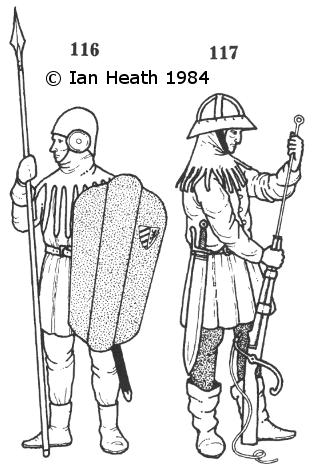Try Amazon Fresh

Find the perfect fit with Amazon Prime. Try Before You Buy.
GERMAN INFANTRYMEN, MID-15th CENTURY
An extract from Armies of the Middle Ages, Volume 2
by Ian Heath

[Primarily based on Feuerwerkbuch, Germany, first quarter of the 15th century. Royal Armouries FEUR 1, England.
Also Sammelhandschrift zur Kriegskunst (Collective manuscript on the art of war). Johannes Wienner (scribe), c.1437. Wien Bildarchiv der Österreichischen Nationalbibliothek Cod. 3062 Han.]
116 & 117. GERMAN INFANTRYMEN, MID-15th CENTURY
These come from mss. of c.1430-40.
Figure 116 is typical of lighter-armoured foot-soldiers of this period, wearing for his protection only a sallet with rondel ear-guards,
and boiled leather gauntlets which are doubtless of the type seen by Bertrandon de la Brocquière in 1433, which in his opinion were strong as gauntlets of iron.
Other men inevitably wore the usual mail, plate and brigandine armour of figures such as are depicted, for example,
in figures 48,
70, 119 and 128 in volume 1.
By this date shields, where carried at all by German infantry, were invariably pavises, for further details of which see notes to figures 123a-e below.
117 is a handgunner. The handgun had appeared in Germany by c.1380 at the very latest, and probably about a decade earlier.
Clephan, in his Outline of the History and Development of Hand Firearms, cites two references dating to 1375,
but the earliest generally accepted reference dates to 1381, when the city of Augsburg is recorded to have had 30 handguns for use against the nobility of Saxony, Bavaria and France.
Emperor Sigismund was accompanied by as many as 500 handgunners during his Romzug of 1431, probably a mixture of Germans, Hungarians and Italians,
while one authority claims that by 1496 as many as one-sixth of all German infantry were handgunners.
In 1480 Württemberg had perhaps as many as 800 handgunners amongst its 3,500 infantry, all of whom were uniformed.
Most handguns were brass-barrelled until the mid-15th century, when iron barrels came to predominate.
The wooden stock, meanwhile, had widened to the point where it could be rested against or on the shoulder towards the end of the 14th century,
and began to be slightly curved (as depicted here) about 1392. This particular gun is fitted with a serpentine matchlock as described under figure 114 in volume 1.
Rammers were probably used in loading from the very beginning, since modern tests indicate that ‘the gunpowder would not explode at all unless it was rammed well down,
with adequate wadding’, hence ‘the very long stocks fitted to the early guns must have been to assist this operation’.*
*Alan R.Williams, Some Firing Tests with simulated Fifteenth-Century Handguns.
Next: 118. GERMAN CAVALRYMAN c.1480 in Armies of the Middle Ages, Volume 2 by Ian Heath
48. CROSSBOWMAN, 15th CENTURY in Armies of the Middle Ages, Volume 1 by Ian Heath
68, 69 & 70. HANDGUNNERS, in Armies of the Middle Ages, Volume 1 by Ian Heath
114. BURGUNDIAN HANDGUNNER, in Armies of the Middle Ages, Volume 1 by Ian Heath


